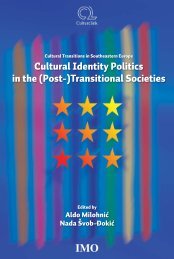D:\Documents and Settings\Ana\My Documents\Biserka-knjiga ...
D:\Documents and Settings\Ana\My Documents\Biserka-knjiga ...
D:\Documents and Settings\Ana\My Documents\Biserka-knjiga ...
You also want an ePaper? Increase the reach of your titles
YUMPU automatically turns print PDFs into web optimized ePapers that Google loves.
The underst<strong>and</strong>ing of media users, as exemplified in the text, has gone through<br />
various transformational models. The participants in the public sphere in the<br />
eighteenth century implied a face-to-face “dialogical exchange” based on publicly<br />
disseminated information, to a large extent mediated by the press, while electronic<br />
media implied a mass audience, engaged in a one-to-many form of communication.<br />
In the first phase, this type of media user was critically evaluated as passive <strong>and</strong><br />
uncritical to the manipulative mass media content, while in the second affirmatively<br />
characterized as active media audiences (plural), who carry creative potentials in<br />
decoding media messages. New digital technology, more specifically the Internet,<br />
has again pushed us back to a “dialogical” or “polilogical” exchange; not<br />
communicated face-to-face but intermediated by the computer.<br />
In this respect, the inhabitants or avatars of the previously explained virtual<br />
Second Life world or the members of Internet social networks such as Facebook<br />
could be analysed as new forms of virtual public spheres. Second Life <strong>and</strong> Facebook<br />
include a diffused type of user engagement (more diverse media technologies, more<br />
individual, intimate user practices). In addition, media users have become products in<br />
a consumer society: a market niche, positioned between the interests of media<br />
producers <strong>and</strong> advertising agencies. Another important question related to the<br />
contemporary perspectives of media users is the issue of media pluralism <strong>and</strong><br />
diversity. On the one h<strong>and</strong> new technologies potentially enable a more pluralized <strong>and</strong><br />
diverse media l<strong>and</strong>scape (in terms of offered channels <strong>and</strong> content) <strong>and</strong> on the other,<br />
we testify to the increasing trend of media ownership concentration, which imperils<br />
the above-mentioned potentials opened up by new technology. For these reasons,<br />
forthcoming media user research will, in addition to issues such as media<br />
digitalization, remediation <strong>and</strong> convergence, have to deal with contemporary<br />
economic issues in a globalized world.<br />
References<br />
Media users: from readership to co-creators<br />
Abercrombie, Nicholas <strong>and</strong> Longhurst, Brian: Dictionary of Media Studies. London,<br />
Penguin, 2007<br />
Anderson, Benedict: Imagined communities. London & New York, Verso, 1983<br />
Ang, Ian: Desperately Seeking the Audience. London, Routledge, 1991<br />
Boyd-Barrett, Oliver: “Conceptualizing the Public Sphere”, in Boyd-Barrett, Oliver<br />
<strong>and</strong> Newbold, Chris (eds): Approaches to Media: A Reader. London, Arnold, 1995<br />
Brunsdon, Charlotte <strong>and</strong> Morley, David: Everyday Television: “Nationwide” BFI,<br />
London, 1978<br />
Comaroff, John L. <strong>and</strong> Comaroff, Jean (eds): Civil Society <strong>and</strong> the Political<br />
Imagination in Africa. Critical Perspectives. University of Chicago Press, 1999<br />
57



